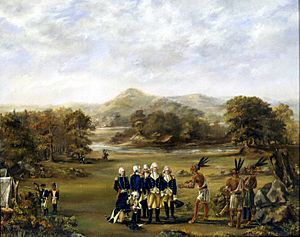Egushawa facts for kids
Egushawa (born around 1726 – died March 1796), also known by many other names, was a powerful war chief and important leader of the Odawa tribe. His name means "The Gatherer" or "Brings Together." He was a very important leader among the Detroit Ottawa, a group living in what is now southeast Michigan and northwest Ohio. Many people saw him as a successor to the famous Chief Pontiac. Egushawa fought in two major wars against the United States, making him one of the most influential Native American leaders in the Great Lakes region in the late 1700s.
Egushawa's Early Life
Egushawa first appears in historical records in 1774. At that time, he signed a document giving an island in the Detroit River to Alexis Masonville. This island was not far from the British Army outpost of Fort Detroit. We don't know much for sure about his life before 1774.
He was likely born near the Detroit River, in what is now Michigan or Ontario. The Odawa people were very strong in this area. Many had settled around Fort Detroit after the French built it in 1701. Their influence and land reached into present-day northwest Ohio, along the Maumee River.
Egushawa became important as a leader after Pontiac, another famous Ottawa leader. Egushawa might have been related to Pontiac. He may have fought against the British during the French and Indian War (1754–1763) as an ally of the French.
Role in the American Revolution
When the American Revolutionary War (1775–1783) began, Egushawa was living in a village. This village was at the mouth of the Maumee River, where Toledo, Ohio is today. Egushawa supported the British efforts in Fort Detroit. He helped them gather Native American allies to attack U.S. settlements in Kentucky.
In April 1777, he traveled with British officials to Vincennes. There, he helped create an alliance with some of the Wabash tribes. For his help, Henry Hamilton, the British lieutenant governor at Detroit, gave Egushawa a sword in June 1777.
Egushawa was very active in the war. He joined St. Leger's expedition in New York. He took part in the bloody Battle of Oriskany on August 6, 1777. In 1778, he was the main chief with Hamilton's group. They tried to recapture Vincennes after Colonel George Rogers Clark of Virginia took it. Egushawa warned the Piankeshaw chief Young Tobacco for working with the Virginians. Clark made a surprise return to Vincennes in 1779 and captured Hamilton. However, Egushawa managed to escape. In 1780, his group of warriors joined Captain Henry Bird's invasion of Kentucky. In this attack, two American fortified settlements were captured.
The 1783 peace treaty ended the Revolutionary War. In this treaty, the British gave the land of their Native American allies to the United States. Without British military support, Native Americans had to sign various peace treaties. These treaties gave parts of the Northwest Territory to the United States. The last of these was the Treaty of Fort Harmar in 1789. Egushawa did not agree with these treaties and did not think they were fair.
Northwest Indian War
After the Revolutionary War, the Shawnee people of the Ohio Country started to form a group. Their goal was to stop the U.S. from taking over the land. This land was given to the U.S. by the British and was called the Northwest Territory. The British secretly supported these efforts. They had refused to leave Fort Detroit and Fort Mackinac, even though the 1783 peace treaty said they should.
Egushawa was at first unsure about joining the Northwest Indian War. But he joined the native Western Confederacy after an American army was defeated in October 1790. This army was led by Josiah Harmar.
As a war chief, a recruiter, and a diplomat to the British, Egushawa became one of the most important leaders in the war. He believed that the only way to have peace was through war. He said that "the enemy trust in their large numbers and strength and not on God, who made them and us, nor on the fairness of their cause." In 1791, he likely led members of the Ottawa, Ojibwe, and Potawatomi groups at the St. Clair's Defeat. This was the worst defeat the United States ever suffered from Native Americans.
In 1794, Egushawa was badly wounded. This happened during the Native American defeat at the Battle of Fallen Timbers in Ohio. This was the last time Egushawa fought in battle.
While recovering, he lived on the Maumee or Raisin rivers. He kept telling other Native American leaders to support the British. However, the British were busy with wars in Europe. So, they did not offer new military help to the Native American resistance.
Egushawa finally agreed to talk about a peace treaty with the Americans. He was one of the last chiefs to do so. He signed the Treaty of Greenville on August 3, 1795. This treaty gave much of southeastern Michigan to the U.S. but kept some of northwest Ohio for Odawa use. He died near Detroit shortly after, probably without leaving any children.


